上海交通大学:SCM供应链管理 Supply Chain Managment》课程教学资料_lecture notes_Lecture7-1-Forecasting
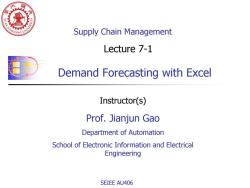
JIAOTONG UNIVERSITY 1096 Supply Chain Management Lecture 7-1 Demand Forecasting with Excel Instructor(s) Prof.Jianjun Gao Department of Automation School of Electronic Information and Electrical Engineering SEIEE AU406
Supply Chain Management Instructor(s) SEIEE AU406 + - Demand Forecasting with Excel Prof. Jianjun Gao Department of Automation School of Electronic Information and Electrical Engineering Lecture 7-1
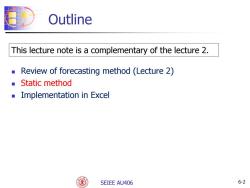
Outline This lecture note is a complementary of the lecture 2. Review of forecasting method (Lecture 2) ■Static method Implementation in Excel SEIEE AU406 6-2
+ - SEIEE AU406 Outline Review of forecasting method (Lecture 2) Static method Implementation in Excel 6-2 This lecture note is a complementary of the lecture 2
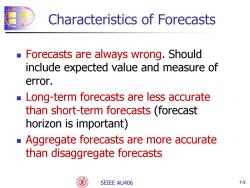
Characteristics of Forecasts Forecasts are always wrong.Should include expected value and measure of error. Long-term forecasts are less accurate than short-term forecasts (forecast horizon is important) Aggregate forecasts are more accurate than disaggregate forecasts SEIEE AU406 7-3
+ - SEIEE AU406 7-3 Characteristics of Forecasts Forecasts are always wrong. Should include expected value and measure of error. Long-term forecasts are less accurate than short-term forecasts (forecast horizon is important) Aggregate forecasts are more accurate than disaggregate forecasts
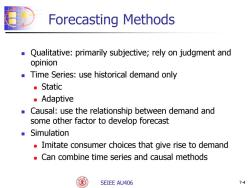
Forecasting Methods Qualitative:primarily subjective;rely on judgment and opinion Time Series:use historical demand only Static ■Adaptive ■ Causal:use the relationship between demand and some other factor to develop forecast Simulation Imitate consumer choices that give rise to demand Can combine time series and causal methods SEIEE AU406 7-4
+ - SEIEE AU406 7-4 Forecasting Methods Qualitative: primarily subjective; rely on judgment and opinion Time Series: use historical demand only Static Adaptive Causal: use the relationship between demand and some other factor to develop forecast Simulation Imitate consumer choices that give rise to demand Can combine time series and causal methods
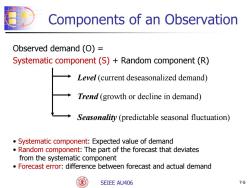
Components of an Observation Observed demand (O)= Systematic component(S)+Random component(R) Level (current deseasonalized demand) Trend (growth or decline in demand) Seasonality (predictable seasonal fluctuation) Systematic component:Expected value of demand Random component:The part of the forecast that deviates from the systematic component Forecast error:difference between forecast and actual demand SEIEE AU406 7-5
+ - SEIEE AU406 7-5 Components of an Observation Observed demand (O) = Systematic component (S) + Random component (R) Level (current deseasonalized demand) Trend (growth or decline in demand) Seasonality (predictable seasonal fluctuation) • Systematic component: Expected value of demand • Random component: The part of the forecast that deviates from the systematic component • Forecast error: difference between forecast and actual demand
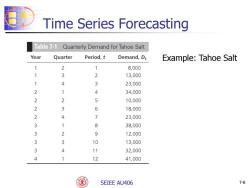
Time Series Forecasting able 7-1 Quarterly Demand for Tahoe Salt Year Quarter Period,t Demand,Dt Example:Tahoe Salt 1 2 1 8,000 1 3 2 13,000 1 4 3 23,000 2 1 4 34,000 2 2 5 10,000 2 3 6 18,000 2 4 7 23,000 3 1 8 38,000 3 2 9 12,000 3 3 10 13,000 34 4 11 32,000 1 12 41,000 SEIEE AU406 7-6
+ - SEIEE AU406 7-6 Time Series Forecasting Example: Tahoe Salt

Time Series Forecasting 50.000 40.000 puew d 30.000 20.000 10.000 0 1,21,31,42,12,22,32,43,13,23,33,44,1 Period Do you find any pattern? SEIEE AU406 7-7
+ - SEIEE AU406 7-7 Time Series Forecasting Do you find any pattern?
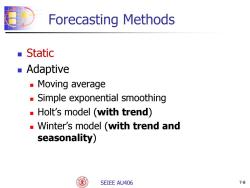
Forecasting Methods Static Adaptive Moving a average Simple exponential smoothing Holt's model (with trend) Winter's model (with trend and seasonality) SEIEE AU406 7-8
+ - SEIEE AU406 7-8 Forecasting Methods Static Adaptive Moving average Simple exponential smoothing Holt’s model (with trend) Winter’s model (with trend and seasonality)
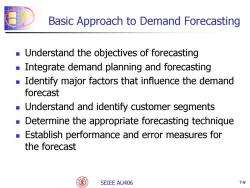
Basic Approach to Demand Forecasting Understand the objectives of forecasting Integrate demand planning and forecasting Identify major factors that influence the demand forecast Understand and identify customer segments ■ Determine the appropriate forecasting technique Establish performance and error measures for the forecast SEIEE AU406 7-9
+ - SEIEE AU406 7-9 Basic Approach to Demand Forecasting Understand the objectives of forecasting Integrate demand planning and forecasting Identify major factors that influence the demand forecast Understand and identify customer segments Determine the appropriate forecasting technique Establish performance and error measures for the forecast
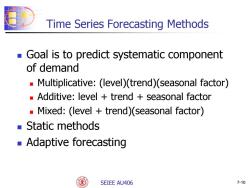
Time Series Forecasting Methods Goal is to predict systematic component of demand Multiplicative:(level)(trend)(seasonal factor) Additive:level trend seasonal factor Mixed:(level trend)(seasonal factor) Static methods Adaptive forecasting SEIEE AU406 7-10
+ - SEIEE AU406 7-10 Time Series Forecasting Methods Goal is to predict systematic component of demand Multiplicative: (level)(trend)(seasonal factor) Additive: level + trend + seasonal factor Mixed: (level + trend)(seasonal factor) Static methods Adaptive forecasting
按次数下载不扣除下载券;
注册用户24小时内重复下载只扣除一次;
顺序:VIP每日次数-->可用次数-->下载券;
- 上海交通大学:SCM供应链管理 Supply Chain Managment》课程教学资料_lecture notes_Lecture6-Global_SCM.pdf
- 上海交通大学:SCM供应链管理 Supply Chain Managment》课程教学资料_lecture notes_Lecture5-2networkdesign.pdf
- 上海交通大学:SCM供应链管理 Supply Chain Managment》课程教学资料_lecture notes_Lecture5-1distribution.pdf
- 上海交通大学:SCM供应链管理 Supply Chain Managment》课程教学资料_lecture notes_Lecture4-metric.pdf
- 上海交通大学:SCM供应链管理 Supply Chain Managment》课程教学资料_lecture notes_Lecture3-Strategic_fit.pdf
- 上海交通大学:SCM供应链管理 Supply Chain Managment》课程教学资料_lecture notes_Lecture2-Demand forecasting.pdf
- 上海交通大学:SCM供应链管理 Supply Chain Managment》课程教学资料_lecture notes_Lecture11-Optimal-Product-Availability.pdf
- 上海交通大学:SCM供应链管理 Supply Chain Managment》课程教学资料_lecture notes_Lecture11-examples-Product.pdf
- 上海交通大学:SCM供应链管理 Supply Chain Managment》课程教学资料_lecture notes_Lecture10-Safe-Inventory.pdf
- 上海交通大学:SCM供应链管理 Supply Chain Managment》课程教学资料_lecture notes_Lecture10-examples-safty-inventory.pdf
- 上海交通大学:SCM供应链管理 Supply Chain Managment》课程教学资料_lecture notes_Lecture1-Introduction.pdf
- 上海交通大学:SCM供应链管理 Supply Chain Managment》课程教学资料_lecture notes_Beer_Game_instruction.pdf
- 上海交通大学:SCM供应链管理 Supply Chain Managment》课程教学资料_lecture notes_amazon financial statement.pdf
- 上海交通大学:SCM供应链管理 Supply Chain Managment》课程教学资料_homework_sol2.pdf
- 上海交通大学:SCM供应链管理 Supply Chain Managment》课程教学资料_homework_sol1.pdf
- 上海交通大学:SCM供应链管理 Supply Chain Managment》课程教学资料_homework_hw2_scm2014.pdf
- 上海交通大学:SCM供应链管理 Supply Chain Managment》课程教学资料_homework_hw1_scm2014.pdf
- 上海交通大学:《职业生涯发展与规划》课程教学资源(学习文件)大学生职业生涯规划书(二).docx
- 上海交通大学:《职业生涯发展与规划》课程教学资源(学习文件)大学生职业生涯规划书(一).docx
- 上海交通大学:《职业生涯发展与规划》课程教学资源(PPT课件讲稿)第04讲 生涯技能探索.ppt
- 上海交通大学:SCM供应链管理 Supply Chain Managment》课程教学资料_lecture notes_Lecture7-2-Aggregated-Planning.pdf
- 上海交通大学:SCM供应链管理 Supply Chain Managment》课程教学资料_lecture notes_Lecture8-Information-Bullwhip.pdf
- 上海交通大学:SCM供应链管理 Supply Chain Managment》课程教学资料_lecture notes_Lecture9-Cycle-Inventory.pdf
- 上海交通大学:SCM供应链管理 Supply Chain Managment》课程教学资料_lecture notes_lecture9-examples-cycle-inventory.pdf
- 上海交通大学:SCM供应链管理 Supply Chain Managment》课程教学资料_lecture notes_LP and Excel solver.pdf
- 公共行政与公共管理经典译丛:[美]乔治·弗雷德里克森《公共行政的精神 The Spirit of Public Administration》.pdf
- 《公共行政概论》课程教学资源(阅读资料)对政治与行政二分原则的审查(中国人民大学:张康之).pdf
- 《公共行政概论》课程教学资源(阅读书籍)[美]戴维·奥斯本、特德·盖布勒《改革政府:企业家精神如何改革着公共部门》.pdf
- 《公共行政概论》课程教学资源(阅读资料)政治与行政两分法——思想渊源及其评价.pdf
- 《公共行政概论》课程教学资源(阅读资料)政治与行政二分法批判的批判.pdf
- 《公共行政概论》课程教学资源(阅读资料)政治与行政二分理论研究综述.pdf
- 政府治理与改革系列:(美)珍妮特·V·登哈特、罗伯特·B·登哈特《新公共服务:服务,而不是掌舵》THE NEW PUBLIC SERVICE SERVING, NOT STEERING.pdf
- 《公共行政概论》课程教学资源(阅读资料)西方政治与行政关系的历史演变及趋势.pdf
- 《中国行政管理》:“协同政府”——新公共管理改革的新阶段.pdf
- 《公共行政概论》课程教学资源(阅读资料)从新公共管理到整体性治理.pdf
- 《公共行政概论》课程教学资源(阅读资料)从竞争治理迈向整体治理.pdf
- 《公共行政概论》课程教学资源(阅读资料)全观型治理——理论与制度化策略.pdf
- 《公共行政概论》课程教学资源(阅读书籍)[美]彼得·圣吉《第五项修炼——学习型组织的艺术与实务》PDF电子书(The Fifth Discipline).pdf
- 《公共行政概论》课程教学资源(参考资料)上海市城市管理行政执法条例.docx
- 《公共行政概论》课程教学资源(阅读书籍)【英】罗素《权力论》中文版.pdf
